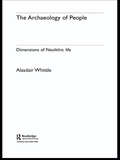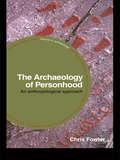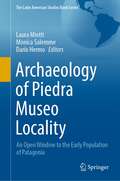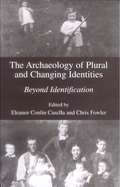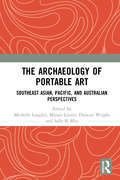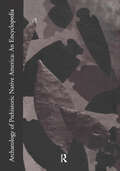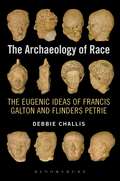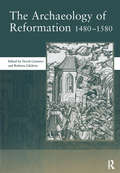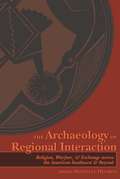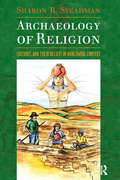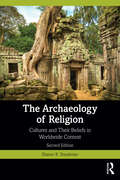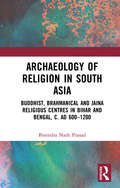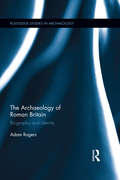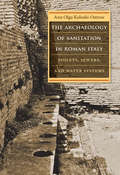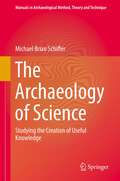- Table View
- List View
The Archaeology of People: Dimensions of Neolithic Life
by Alisdair WhittleAlasdair Whittle's new work argues powerfully for the complexity and fluidity of life in the Neolithic, through a combination of archaeological and anthropological case studies and current theoretical debate. The book ranges from the sixth to the fourth millennium BC, and from the Great Hungarian Plain, central and western Europe and the Alpine foreland to parts of southern Britain. Familiar terms such as individuals, agency, identity and structure are dealt with, but Professor Whittle emphasises that they are too abstract to be truly useful.Instead, he highlights the multiple dimensions which constituted Neolithic existence: the web of daily routines, group and individual identities, relations with animals, and active but varied attitudes to the past. The result is a vivid, original and perceptive understanding of the early Neolithic which will offer insights to readers at every level.
The Archaeology of People: Dimensions of Neolithic Life
by Alisdair WhittleAlasdair Whittle's new work argues powerfully for the complexity and fluidity of life in the Neolithic, through a combination of archaeological and anthropological case studies and current theoretical debate. The book ranges from the sixth to the fourth millennium BC, and from the Great Hungarian Plain, central and western Europe and the Alpine foreland to parts of southern Britain. Familiar terms such as individuals, agency, identity and structure are dealt with, but Professor Whittle emphasises that they are too abstract to be truly useful.Instead, he highlights the multiple dimensions which constituted Neolithic existence: the web of daily routines, group and individual identities, relations with animals, and active but varied attitudes to the past. The result is a vivid, original and perceptive understanding of the early Neolithic which will offer insights to readers at every level.
The Archaeology of Personhood: An Anthropological Approach
by Chris FowlerBringing together a wealth of research in social and cultural anthropology, philosophy and related fields, this is the first book to address the contribution that an understanding of personhood can make to our interpretations of the past Applying an anthropological approach to detailed case studies from European prehistoric archaeology, the book explores the connection between people, animals, objects, their societies and environments and investigates the relationship that jointly produces bodies, persons, communities and artefacts. The Archaeology of Personhood examines the characteristics that define a person as a category of being, highlights how definitions of personhood are culturally variable and explores how that variation is connected to human uses of material culture.
The Archaeology of Personhood: An Anthropological Approach
by Chris FowlerBringing together a wealth of research in social and cultural anthropology, philosophy and related fields, this is the first book to address the contribution that an understanding of personhood can make to our interpretations of the past Applying an anthropological approach to detailed case studies from European prehistoric archaeology, the book explores the connection between people, animals, objects, their societies and environments and investigates the relationship that jointly produces bodies, persons, communities and artefacts. The Archaeology of Personhood examines the characteristics that define a person as a category of being, highlights how definitions of personhood are culturally variable and explores how that variation is connected to human uses of material culture.
Archaeology of Piedra Museo Locality: An Open Window to the Early Population of Patagonia (The Latin American Studies Book Series)
by Laura Miotti Monica Salemme Darío HermoThis book highlights the knowledge about landscapes and characteristics of the earliest hunter-gatherer lifeway in Southern Patagonia. It presents an analysis of the archaeological investigations carried out during three decades by an interdisciplinary team that involved archaeologists, anthropologists, paleontologists, geologists and specialists in pollen and diatoms. The database yielded was recovered from systematic survey and excavations from the Pleistocene and Holocene stratigraphic layers of the rockshelter known as AEP-1, Piedra Museo Locality, situated in the central plateau of Santa Cruz Province, Argentina. Piedra Museo is a unique place in the world of high academic interest with some of the earliest archaeological remains in the Americas. Researchers defined two strata and several Stratigraphic units in the site based on the sedimentological and pedological characteristics. The depositional zones contain archaeological remains that are interpreted as hunting events corresponding to two main different occasions in the human colonization of the region, and a third human occupation during the Middle Holocene. Last one occurred then of the massive rockshelter roof colapse. The faunal remains led to a new approach to the palaeoenvironmental evolution of this enclosed basin. This volume describes the management of lithic raw materials and social networks from first human occupation of the Patagonian region to territorial consolidation of hunter-gatherer societies.
The Archaeology of Plural and Changing Identities: Beyond Identification
by Eleanor Casella Chris FowlerAs people move through life, they continually shift affiliation from one position to another, dependent on the wider contexts of their interactions. Different forms of material culture may be employed as affiliations shift, and the connotations of any given set of artifacts may change. In this volume the authors explore these overlapping spheres of social affiliation. Social actors belong to multiple identity groups at any moment in their life. It is possible to deploy one or many potential labels in describing the identities of such an actor. Two main axes exist upon which we can plot experiences of social belonging – the synchronic and the diachronic. Identities can be understood as multiple during one moment (or the extended moment of brief interaction), over the span of a lifetime, or over a specific historical trajectory. From the Introduction The international contributions each illuminate how the various identifiers of race, ethnicity, sexuality, age, class, gender, personhood, health, and/or religion are part of both material expressions of social affiliations, and transient experiences of identity. The Archaeology of Plural and Changing Identities: Beyond Identification will be of great interest to archaeologists, anthropologists, historians, curators and other social scientists interested in the mutability of identification through material remains.
The Archaeology of Portable Art: Southeast Asian, Pacific, and Australian Perspectives
by Michelle C. Langley Mirani Litster Duncan Wright Sally K. MayThe development of complex cultural behaviour in our own species is perhaps the most significant research issue in modern archaeology. Until recently, it was believed that our capacity for language and art only developed after some of our ancestors reached Europe around 40,000 years ago. Archaeological discoveries in Africa now show that modern humans were practicing symbolic behaviours prior to their dispersal from that continent, and more recent discoveries in Indonesia and Australia are once again challenging ideas about human cultural development. Despite these significant discoveries and exciting potentials, there is a curious absence of published information about Asia-Pacific region, and consequently, global narratives of our most celebrated cognitive accomplishment — art — has consistently underrepresented the contribution of Southeast Asia, Australia, and the Pacific Islands. This volume provides the first outline of what this region has to offer to the world of art in archaeology. Readers undertaking tertiary archaeology courses interested in the art of the Asia-Pacific region or human behavioural evolution, along with anyone who is fascinated by the development of our modern ability to decorate ourselves and our world, should find this book a good addition to their library.
The Archaeology of Portable Art: Southeast Asian, Pacific, and Australian Perspectives
by Michelle Langley Mirani Litster Duncan Wright Sally K. MayThe development of complex cultural behaviour in our own species is perhaps the most significant research issue in modern archaeology. Until recently, it was believed that our capacity for language and art only developed after some of our ancestors reached Europe around 40,000 years ago. Archaeological discoveries in Africa now show that modern humans were practicing symbolic behaviours prior to their dispersal from that continent, and more recent discoveries in Indonesia and Australia are once again challenging ideas about human cultural development. Despite these significant discoveries and exciting potentials, there is a curious absence of published information about Asia-Pacific region, and consequently, global narratives of our most celebrated cognitive accomplishment — art — has consistently underrepresented the contribution of Southeast Asia, Australia, and the Pacific Islands. This volume provides the first outline of what this region has to offer to the world of art in archaeology. Readers undertaking tertiary archaeology courses interested in the art of the Asia-Pacific region or human behavioural evolution, along with anyone who is fascinated by the development of our modern ability to decorate ourselves and our world, should find this book a good addition to their library.
Archaeology of Prehistoric Native America: An Encyclopedia
by Guy GibbonFirst published in 1998. Did prehistoric humans walk to North America from Siberia? Who were the inhabitants of the spectacular Anasazi cliff dwellings in the Southwest and why did they disappear? Native Americans used acorns as a major food source, but how did they get rid of the tannic acid which is toxic to humans? How does radiocarbon dating work and how accurate is it? Written for the informed lay person, college-level student, and professional, Archaeology of Prehistoric Native America: An Encyclopedia is an important resource for the study of the earliest North Americans; including facts, theories, descriptions, and speculations on the ancient nomads and hunter-gathers that populated continental North America.
Archaeology of Prehistoric Native America: An Encyclopedia
by Guy E. GibbonFirst published in 1998. Did prehistoric humans walk to North America from Siberia? Who were the inhabitants of the spectacular Anasazi cliff dwellings in the Southwest and why did they disappear? Native Americans used acorns as a major food source, but how did they get rid of the tannic acid which is toxic to humans? How does radiocarbon dating work and how accurate is it? Written for the informed lay person, college-level student, and professional, Archaeology of Prehistoric Native America: An Encyclopedia is an important resource for the study of the earliest North Americans; including facts, theories, descriptions, and speculations on the ancient nomads and hunter-gathers that populated continental North America.
The Archaeology of Race: The Eugenic Ideas of Francis Galton and Flinders Petrie
by Debbie ChallisHow much was archaeology founded on prejudice? The Archaeology of Race explores the application of racial theory to interpret the past in Britain during the late Victorian and Edwardian period. It investigates how material culture from ancient Egypt and Greece was used to validate the construction of racial hierarchies. Specifically focusing on Francis Galton's ideas around inheritance and race, it explores how the Egyptologist Flinders Petrie applied these in his work in Egypt and in his political beliefs. It examines the professional networks formed by societies, such as the Anthropological Institute, and their widespread use of eugenic ideas in analysing society.Archaeology of Race draws on archives and objects from the Petrie Museum of Egyptian Archaeology and the Galton collection at UCL. These collections are used to explore anti-Semitism, skull collecting, New Race theory and physiognomy. These collections give insight into the relationship between Galton and Petrie and place their ideas in historical context.
The Archaeology of Race: The Eugenic Ideas of Francis Galton and Flinders Petrie
by Debbie ChallisHow much was archaeology founded on prejudice? The Archaeology of Race explores the application of racial theory to interpret the past in Britain during the late Victorian and Edwardian period. It investigates how material culture from ancient Egypt and Greece was used to validate the construction of racial hierarchies. Specifically focusing on Francis Galton's ideas around inheritance and race, it explores how the Egyptologist Flinders Petrie applied these in his work in Egypt and in his political beliefs. It examines the professional networks formed by societies, such as the Anthropological Institute, and their widespread use of eugenic ideas in analysing society.Archaeology of Race draws on archives and objects from the Petrie Museum of Egyptian Archaeology and the Galton collection at UCL. These collections are used to explore anti-Semitism, skull collecting, New Race theory and physiognomy. These collections give insight into the relationship between Galton and Petrie and place their ideas in historical context.
The Archaeology of Reformation,1480-1580
by David GaimsterTraditionally the Reformation has been viewed as responsible for the rupture of the medieval order and the foundation of modern society. Recently historians have challenged the stereotypical model of cataclysm, and demonstrated that the religion of Tudor England was full of both continuities and adaptations of traditional liturgy, ritual and devoti
The Archaeology of Reformation,1480-1580
by David GaimsterTraditionally the Reformation has been viewed as responsible for the rupture of the medieval order and the foundation of modern society. Recently historians have challenged the stereotypical model of cataclysm, and demonstrated that the religion of Tudor England was full of both continuities and adaptations of traditional liturgy, ritual and devoti
The Archaeology of Regional Interaction: Religion, Warfare, and Exchange across the American Southwest and Beyond (Proceedings of SW Symposium)
by Michelle HegmonHow and why did styles, materials, conflicts, and religious ideas spread across prehistoric landscapes? The Archaeology of Regional Interaction investigates these questions, using the rich resource of the American Southwest and covering periods from the Folsom to the nineteenth century. Editor Michelle Hegmon has compiled superbly researched essays into a comprehensive examination of regional interaction that has proved itself a pivotal archaeological text. The Archaeology of Regional Interaction surpasses most regional studies, which only focus on settlement patterns or exchange, and considers other forms of interaction, such as intermarriage and the spread of religious practices. Contributors focus especially on understanding the social processes that underlie archaeological evidence of interaction. The essays in this volume examine what regional systems involve, in terms of political and economic relations, and how they can be identified. One essay by Steven LeBlanc provides a sweeping analysis of conflict, a form of regional interaction that has received relatively little attention in the Southwest until recently. A series of chapters devoted to expanding the coverage beyond the borders of the traditional Southwest examines the surrounding areas, including Nevada and Utah, northern Mexico, and the Plains.The volume also provides a unique treatment of religion - including manifestations such as Flower World Iconography, Medicine Societies, and ceremonial textiles - as a form of regional interrelation.
Archaeology of Religion: Cultures and their Beliefs in Worldwide Context
by Sharon R SteadmanSteadman fills an empty niche in the offerings on how archaeology interprets past religions with this useful textbook. The book includes case studies from around the world, from the study of Upper Paleolithic religions and of shamans in foraging societies to formal religious structures in advanced complex societies of Mesopotamia, Egypt, India and the Andes. Steadman also includes key contemporary religions—Christianity, Islam, and Buddhism, among others—to provide an historical and comparative context. This is an ideal text for a archaeology of religion courses and classes that include a significant component on “past religions,” as well as an excellent guide for general readers.
Archaeology of Religion: Cultures and their Beliefs in Worldwide Context
by Sharon R SteadmanSteadman fills an empty niche in the offerings on how archaeology interprets past religions with this useful textbook. The book includes case studies from around the world, from the study of Upper Paleolithic religions and of shamans in foraging societies to formal religious structures in advanced complex societies of Mesopotamia, Egypt, India and the Andes. Steadman also includes key contemporary religions—Christianity, Islam, and Buddhism, among others—to provide an historical and comparative context. This is an ideal text for a archaeology of religion courses and classes that include a significant component on “past religions,” as well as an excellent guide for general readers.
The Archaeology of Religion: Cultures and Their Beliefs in Worldwide Context
by Sharon R. SteadmanThe new and updated edition of The Archaeology of Religion explores how archaeology interprets past religions, offering insights into how archaeologists seek out the religious, ritual, and symbolic meaning behind what they discover in their research. The book includes case studies from around the world, from the study of Upper Palaeolithic and hunter-gatherer religions to religious structures and practices in complex societies of the Americas, Mesopotamia, Egypt, India, and China. Steadman also includes chapters on the origins and development of key contemporary religions—Judaism, Christianity, Islam, among others—to provide an historical and comparative context. Three main themes are threaded throughout the book. These main themes involve the intersection between cultural and religious structures (“religion reflects culture”), including the importance of environment in shaping a culture’s religion, the role religion can sometimes play as a method of social control, and the role religion can sometimes play as a key component in revitalizing a culture. Updated with new discoveries and theories and with two new chapters (Hunter-Gatherer Religions; and Cultures in East Asia) and with new sections on Neolithic Western Asia, the book remains an ideal introduction for courses that include a significant component on past cultures and their religions.
The Archaeology of Religion: Cultures and Their Beliefs in Worldwide Context
by Sharon R. SteadmanThe new and updated edition of The Archaeology of Religion explores how archaeology interprets past religions, offering insights into how archaeologists seek out the religious, ritual, and symbolic meaning behind what they discover in their research. The book includes case studies from around the world, from the study of Upper Palaeolithic and hunter-gatherer religions to religious structures and practices in complex societies of the Americas, Mesopotamia, Egypt, India, and China. Steadman also includes chapters on the origins and development of key contemporary religions—Judaism, Christianity, Islam, among others—to provide an historical and comparative context. Three main themes are threaded throughout the book. These main themes involve the intersection between cultural and religious structures (“religion reflects culture”), including the importance of environment in shaping a culture’s religion, the role religion can sometimes play as a method of social control, and the role religion can sometimes play as a key component in revitalizing a culture. Updated with new discoveries and theories and with two new chapters (Hunter-Gatherer Religions; and Cultures in East Asia) and with new sections on Neolithic Western Asia, the book remains an ideal introduction for courses that include a significant component on past cultures and their religions.
Archaeology of Religion in South Asia: Buddhist, Brahmanical and Jaina Religious Centres in Bihar and Bengal, c. AD 600–1200
by Birendra Nath PrasadIn the religious landscape of early medieval (c. AD 600-1200) Bihar and Bengal, poly-religiosity was generally the norm than an exception, which entailed the evolution of complex patterns of inter-religious equations. Buddhism, Brahmanism and Jainism not only coexisted but also competed for social patronage, forcing them to enter into complex interactions with social institutions and processes. Through an analysis of the published archaeological data, this work explores some aspects of the social history of Buddhist, Brahmanical and Jaina temples and shrines, and Buddhist stūpas and monasteries in early medieval Bihar and Bengal. This archaeological history of religions questions many ‘established’ textual reconstructions, and enriches our understanding of the complex issue of the decline of Buddhism in this area. Please note: Taylor & Francis does not sell or distribute the Hardback in India, Pakistan, Nepal, Bhutan, Bangladesh and Sri Lanka.
Archaeology of Religion in South Asia: Buddhist, Brahmanical and Jaina Religious Centres in Bihar and Bengal, c. AD 600–1200
by Birendra Nath PrasadIn the religious landscape of early medieval (c. AD 600-1200) Bihar and Bengal, poly-religiosity was generally the norm than an exception, which entailed the evolution of complex patterns of inter-religious equations. Buddhism, Brahmanism and Jainism not only coexisted but also competed for social patronage, forcing them to enter into complex interactions with social institutions and processes. Through an analysis of the published archaeological data, this work explores some aspects of the social history of Buddhist, Brahmanical and Jaina temples and shrines, and Buddhist stūpas and monasteries in early medieval Bihar and Bengal. This archaeological history of religions questions many ‘established’ textual reconstructions, and enriches our understanding of the complex issue of the decline of Buddhism in this area. Please note: Taylor & Francis does not sell or distribute the Hardback in India, Pakistan, Nepal, Bhutan, Bangladesh and Sri Lanka.
The Archaeology of Roman Britain: Biography and Identity (Routledge Studies in Archaeology)
by Adam RogersWithin the colonial history of the British Empire there are difficulties in reconstructing the lives of people that came from very different traditions of experience. The Archaeology of Roman Britain argues that a similar critical approach to the lives of people in Roman Britain needs to be developed, not only for the study of the local population but also those coming into Britain from elsewhere in the Empire who developed distinctive colonial lives. This critical, biographical approach can be extended and applied to places, structures, and things which developed in these provincial contexts as they were used and experienced over time. This book uniquely combines the study of all of these elements to access the character of Roman Britain and the lives, experiences, and identities of people living there through four centuries of occupation. Drawing on the concept of the biography and using it as an analytical tool, author Adam Rogers situates the archaeological material of Roman Britain within the within the political, geographical, and temporal context of the Roman Empire. This study will be of interest to scholars of Roman archaeology, as well as those working in biographical themes, issues of colonialism, identity, ancient history, and classics.
The Archaeology of Roman Britain: Biography and Identity (Routledge Studies in Archaeology)
by Adam RogersWithin the colonial history of the British Empire there are difficulties in reconstructing the lives of people that came from very different traditions of experience. The Archaeology of Roman Britain argues that a similar critical approach to the lives of people in Roman Britain needs to be developed, not only for the study of the local population but also those coming into Britain from elsewhere in the Empire who developed distinctive colonial lives. This critical, biographical approach can be extended and applied to places, structures, and things which developed in these provincial contexts as they were used and experienced over time. This book uniquely combines the study of all of these elements to access the character of Roman Britain and the lives, experiences, and identities of people living there through four centuries of occupation. Drawing on the concept of the biography and using it as an analytical tool, author Adam Rogers situates the archaeological material of Roman Britain within the within the political, geographical, and temporal context of the Roman Empire. This study will be of interest to scholars of Roman archaeology, as well as those working in biographical themes, issues of colonialism, identity, ancient history, and classics.
The Archaeology of Sanitation in Roman Italy: Toilets, Sewers, and Water Systems (Studies in the History of Greece and Rome)
by Ann Olga Koloski-OstrowThe Romans developed sophisticated methods for managing hygiene, including aqueducts for moving water from one place to another, sewers for removing used water from baths and runoff from walkways and roads, and public and private latrines. Through the archeological record, graffiti, sanitation-related paintings, and literature, Ann Olga Koloski-Ostrow explores this little-known world of bathrooms and sewers, offering unique insights into Roman sanitation, engineering, urban planning and development, hygiene, and public health. Focusing on the cities of Pompeii, Herculaneum, Ostia, and Rome, Koloski-Ostrow's work challenges common perceptions of Romans' social customs, beliefs about health, tolerance for filth in their cities, and attitudes toward privacy. In charting the complex history of sanitary customs from the late republic to the early empire, Koloski-Ostrow reveals the origins of waste removal technologies and their implications for urban health, past and present.
The Archaeology of Science: Studying the Creation of Useful Knowledge (Manuals in Archaeological Method, Theory and Technique #9)
by Michael Brian SchifferThis manual pulls together—and illustrates with interesting case studies—the variety of specialized and generalized archaeological research strategies that yield new insights into science. Throughout the book there are templates, consisting of questions, to help readers visualize and design their own projects. The manual seeks to be as general as possible, applicable to any society, and so science is defined as the creation of useful knowledge—the kinds of knowledge that enable people to make predictions. The chapters in Part I discuss the scope of the archaeology of science and furnish a conceptual foundation for the remainder of the book. Next, Part II presents several specialized, but widely practiced, research strategies that contribute to the archaeology of science. In order to thoroughly ground the manual in real-life applications, Part III presents lengthy case studies that feature the use of historical and archaeological evidence in the study of scientific activities.
